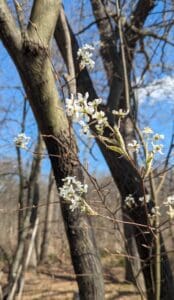
By Jennifer Fairfield
In the flower garden:
July is garden pest time – not my favorite thing to have to deal with in my gardens. So far, the sawfly larva have been hard at work making my hardy hibiscus leaves into lace, while the flea beetles are putting tiny holes in the rest of the hibiscus leaves.
The sawflies are one of my least-favorite pests – they’re just really destructive, and also a little creepy! So, I grabbed my insecticidal soap and headed out to spray them. Just as I was about to take aim, I saw another insect hiding under one of the leaves – a firefly (or lightning bug, if you prefer).
It was a good reminder to me that broadcast spraying of insecticides is never a good idea, as you are likely to harm insects that you don’t intend to (fireflies are totally harmless to our plants, and their populations are in decline – learn more about them from the Xerces Society).
The best thing to do when using insecticides is to do targeted spraying. Be sure to read the labels on products to be sure that you are using the right product for the pest you are trying to rid your plants of, and to know when to spray. Using insecticides at dusk is generally a good practice, as you are less likely to harm bees and other beneficial insects. Neem oil, in particular, should not be used on many plants when it’s sunny out, as it can burn the leaves, and possibly cause more damage than the insects do.
Japanese beetles are also starting to show up in large numbers now. The best way to deal with Japanese beetles is to simply pluck them (or shake them) off the plants and drop them into a bucket of soapy water. The soap coats their wings, making it impossible for them to get out of the water, and they eventually drown.
Japanese beetles are most active in the warmest part of the day, so you are more likely to have more luck getting them in the afternoon, especially if it’s cool in the morning. Getting as many as you see on a daily basis will help keep them under control. If you wait too long, the few you have will suddenly turn into a mob, because when they find a plant they like, they send out a signal to all their friends to join them.
Fertilize your annual flowers early this month. It takes a lot of energy to put out all those beautiful blossoms, so giving them a fertilizer boost now will help them to keep blooming. Fertilize flowers in containers weekly. With frequent watering, fertilizer tends to get flushed out of the container (yellow leaves are often a sign of a lack of nutrients), so regular feedings are a must – just be careful not to over do it, because you can easily burn your plants with too much fertilizer.
Also, don’t forget to deadhead. By removing dead flowers, you encourage the growth of new ones throughout the season, and for those plants that don’t require deadheading, it still keeps your plants looking nice.
Most established perennials don’t need to be fertilized, or need very little fertilizer. MSU’s extension service has advice for what and when to fertilize, when it comes to perennials.
Roses are an exception to the rule, when it comes to fertilizing perennials. Be sure to fertilize roses throughout the month, but stop fertilizing at the end of the month to allow the new growth to harden off before winter. Also remove diseased leaves immediately and pick up any that have fallen to keep diseases under control. Aphids and mites can be major rose pests and can cause serious damage if not kept under control.
Careful spraying when these pests are spotted is generally all that is necessary. Regular fungicide spraying will also help keep your roses healthy, as they can be very susceptible to things like powdery mildew and black spot.
Keep weeds under control in the flower garden, so they don’t compete with your flowers for moisture and nutrients.
Deadhead perennial flowers that have finished blooming. For some, this may help bring a second bloom, but mostly, it helps the plant put energy into putting out more roots, rather than maturing seeds. Of course, if you want more flowers next year, letting your flowers go to seed can be a great way to get more.
Just be careful what you wish for. In one of my native plant beds, I have to keep on top of a particular flower, to keep it from taking over the whole space. Sneezeweed (Helenium autumnale), is an absolutely gorgeous native that blooms from about mid-July all the way up until we get hard frosts.
It is a favorite of the bees and butterflies in my yard, and it produces tons of seeds, if left to its own devices. I am forever pulling out the small volunteer plants everywhere – even on the other side of the yard.
(Publisher’s message: Part 2 will publish tomorrow.)














